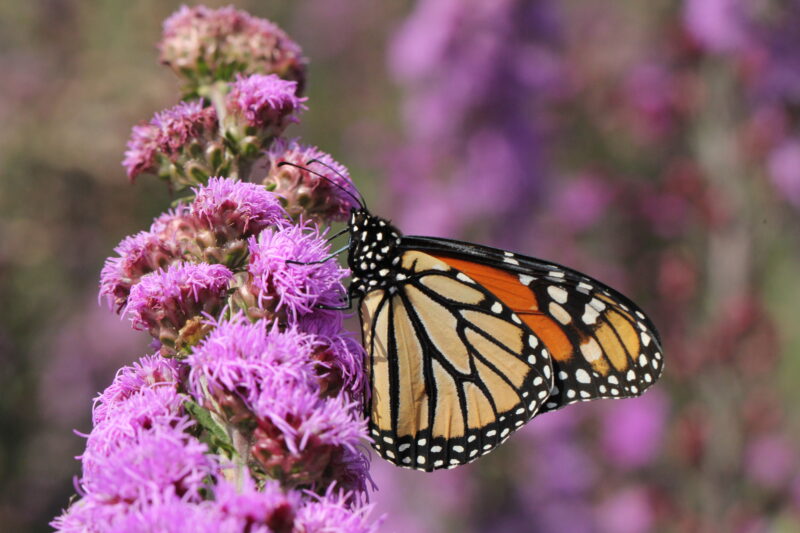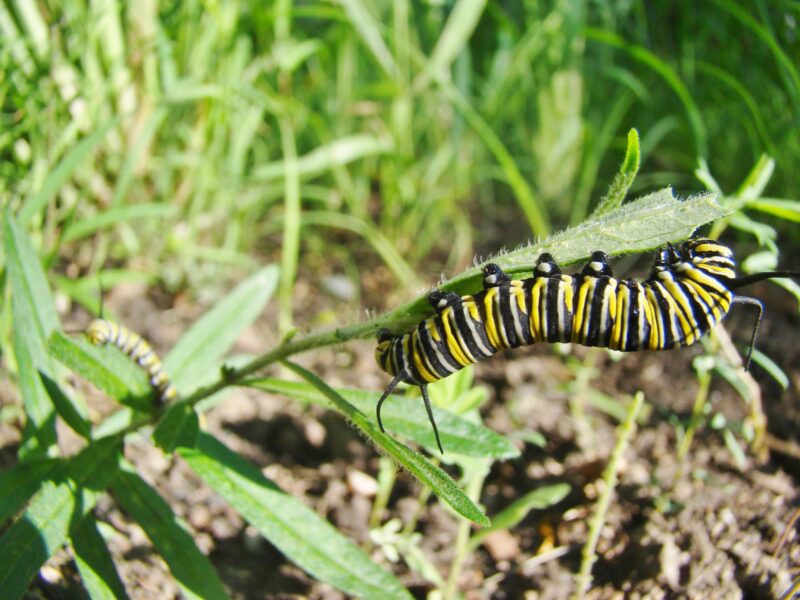
June 17-23, 2024 is Pollinator Week! Initiated and managed by Pollinator Partnership, National Pollinator Week was designated in 2008 by the U.S. Senate as a necessary step toward addressing the urgent issue of declining pollinator populations. In the years since, Pollinator Week has grown into an international celebration of all that pollinators do for our ecosystems and an opportunity to spread the word about what we can do to protect them.
This year, the theme of Pollinator Week is “Vision 2040: Thriving ecosystems, economies, and agriculture.” Here at Blue Thumb, we share resources for Minnesotans to help pollinators and the interrelated systems they support, starting from actions we can take in our own yards.
We are not alone in this work—there are many other organizations statewide and nationally who provide resources and opportunities for conserving pollinators. We want to highlight just a few in this blog post and invite you to consider what new action you can commit to taking for pollinators this Pollinator Week!
Pollinator Partnership is a nonprofit that works to protect pollinators and their habitat with projects all over North America and globally. Register your Pollinator Week events and activities to the official Pollinator Week events map, and explore activity ideas in their Pollinator Week Toolkit.
One event that you can be anywhere in North America to take part in is the Pollinator Week BioBlitz on iNaturalist. This community science project, hosted by the North American Pollinator Protection Campaign’s (NAPPC) Pollinator Communications Task Force, is easy to join and involves taking pictures of pollinators and the flowers they are visiting and uploading them to iNaturalist to be included in the dataset.

Monarch Joint Venture is a national partnership working to conserve monarch butterflies and other pollinators. Monarchs face many threats that result in declining populations throughout their North American range. One of the best things you can do for monarchs is to plant pollinator habitat. Even a few plants can make an impact! Explore Monarch Joint Venture’s website for resources including:
- Habitat Help Desk: A free resource for owners and managers of private working lands, providing pointed and regionally appropriate guidance for habitat goals of any size.
- Community Science Opportunities: To help understand monarch migration, community scientists are needed for collecting data on monarchs at all stages of their life cycle.
- Education and How-To Guides: Monarch Joint Venture has a wealth of webinar recordings, habitat creation guides, and more on their website.
University of Minnesota Bee Lab
The Bee Lab’s mission is to promote the conservation, health, and diversity of bee pollinators through research, education, and hands-on mentorship. Their website is a great resource for learning about the diversity of bees in Minnesota (over 500 species!) and current research on bees in the state.
One (often overlooked) way to support native bees that the Bee Lab provides information on is creating nesting habitat. While we usually think of planting native blooms to provide pollen and nectar for bees, they also need places to overwinter and hibernate.
The Bee Lab has also recently opened a community science program called the Nest Quest, where you can search and report for bumble bee nests in Twin Cities parks. Nest findings will help the Bee Lab develop strategies to protect bumble bee nesting habitat. Learn more and sign up to attend a training at nestquest.umn.edu.
The Xerces Society for Invertebrate Conservation
The Xerces Society is a national nonprofit that works with partners to restore and expand habitat and further the science of pollinator conservation. Their Pollinator Conservation Resource Center houses region-specific collections of publications, native plant and seed suppliers, and other pollinator habitat resources.
If you’re looking for more community science opportunities, Xerces Society’s Bumble Bee Atlas Program gathers data for tracking and conserving bumble bees. Xerces Society provides workshops that equip you with the skills to conduct catch-and-release bumble bee surveys in your area!
Homegrown National Park is a movement that inspires people to address the biodiversity crisis by adding native plants and removing invasive ones where we live, work, learn, pray, and play.
Explore their Biodiversity Map™ to see what folks are doing around the country to plant for wildlife. Join the movement by adding your own native plantings (as small as one square foot!) to the Biodiversity Map. Use their Keystone Plant Guides to find plants that support a high number of insects and pollinators. Search for container-friendly flowering plants as well as trees and shrubs by ecoregion.
The Blue Thumb Partnership is a network of Minnesota clean water and native plant professionals, including landscape design and install businesses, native plant nurseries, turf alternative experts, and more. If you’re looking for help on a pollinator planting project, use our Partner Finder to seek out companies that specialize in sustainable practices and have an understanding of native plant habitat. Interested in joining the Partnership? Learn more on our Partnership Information page.
What will you be doing for Pollinator Week this year? Our actions have an even bigger impact when we tell others about them. Use the #PollinatorWeek hashtag to share what you’re up to this week on social media! Through our collective action, we can work to help pollinators not just survive, but thrive.
– Megan Reich, Metro Blooms Communications and Program Manager

